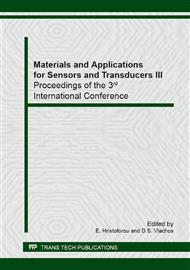[1]
Z. Zhao and H. Jiang: Academy of Sciences, 10 (2) (2010), p.1216.
Google Scholar
[2]
Zhang Ming, Li Limiao, Du Z., Xu Shoujiang, Li Chengchao, Chen Xian, Zhang Tiafang and Wang Taihong: Sensor Letters, 7 (4) (2009), p.543.
Google Scholar
[3]
Y. H. Won, D. Aboagye, H. S. Jang, A. Jitianu and L. A. Stanciu: Journal Materials Chemistry, 20 (2010), p.5030.
Google Scholar
[4]
K. Thenmozhi and S. Sriman Narayanan: Sens. and Actuators B: Chemical, 125 (2007), p.195.
Google Scholar
[5]
S. Helali, H. Baccar, A. Abdelghani, and N. Jaffrezic Renault :Sensor Letters, 7 (5) 2009, p.808.
Google Scholar
[6]
S. Chen, R. Yuan, Y. Q. Chai and F. X. Hu: Microchimica Acta, 180 (2013), p.15.
Google Scholar
[7]
N. Q. Jia, Q. Zhou, L. Liu, M. M. Yan and Z. Y. Jiang: Journal of Electroanalytical Chemistry, 580 (2005), p.213.
Google Scholar
[8]
J. Jegan Roy, T. Emilia Abraham, K.S. Abhijith, P.V. Sujith Kumar and M.S. Thakur: Biosensors and Bioelectronics Journals, 21 (2005), p.206.
Google Scholar
[9]
Y. Zhang, G. M. Zeng, L. Tang, D. L. Huang, X. Y. Jiang and Y. N. Chen: Biosensors and Bioelectronics Journals, 22 (2007), p.2121.
Google Scholar
[10]
L. Zhang, Q. Zhang and J. H. Li: Advanced Funct. Mater., 17 (2007), p.1958.
Google Scholar
[11]
H. Zhou, X. Gan, J. Wang, X. L. Zhu and G. X. Li: Anal. Chem., 77 (2005), p.6102.
Google Scholar
[12]
A. K. M. Kafi, G. S. Wu and A. C. Chen: Biosensor and Bioelectronics, 24 (2008), p.566.
Google Scholar
[13]
X. L. Xiao, W. Lu and X. Yao, Electro analysis, 20 (2008), p.2247.
Google Scholar
[14]
M. Luo, K. Cheng, W.J. Weng, C. L. Song, P. Y. Du, G. Shen, G. Xu and G. R. Han: Nanotechnology, 20 (2009), p.215605.
Google Scholar
[15]
A. A. Ansari, P. R. Solanki and B. D.: Malhotra, Biotechnology Journal, 46 (2009), p.132.
Google Scholar
[16]
Y. J. Teng, S. H. Zuo and M. B. Lan: Biosensor and Bioelectronics, 24 (2009), p.1353.
Google Scholar
[17]
A.J. Bard, and L. R. Faulkner in: Electro-chemical Methods: Fundamentals and Applications, 2nd edition, John Wiley & Sons, Inc., NY (2001).
Google Scholar
[18]
N. J. Miller and J. C. Miller in: Statistics and chemometrics for analytical Chemistry, Fifth edition, 2005, p.121.
Google Scholar


